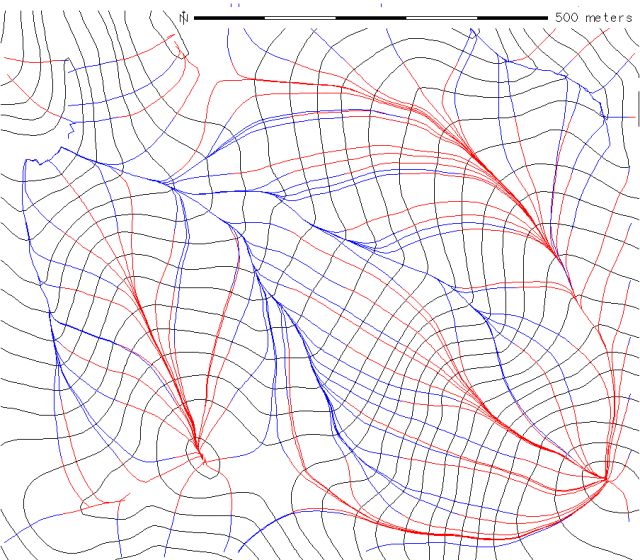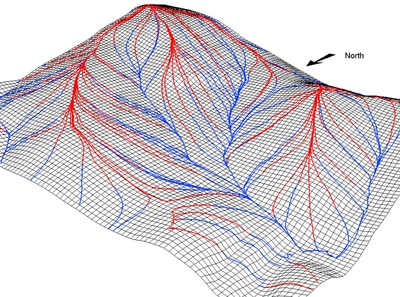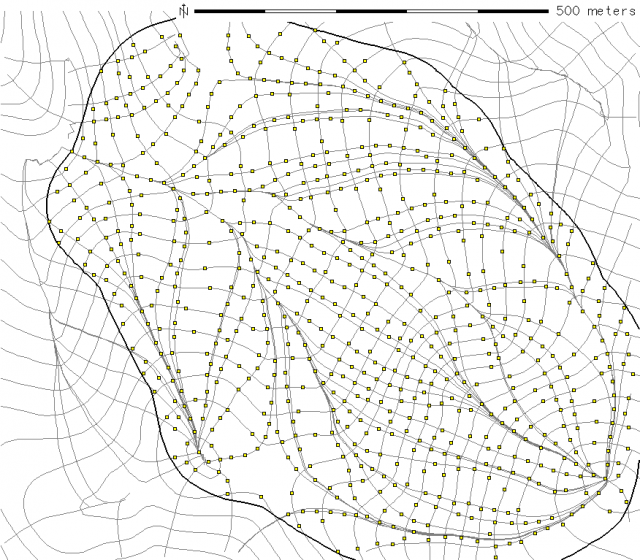Home » Projects » Rangeland Soil Management and Hydrology » Watershed-scale Hydropedology » Hydrologic Modeling in Oak Woodland Soilscapes » SFREC » Elevation Survey by RTK » Establishing the Optimal Number of Survey Points
Establishing the Optimal Number of Survey Points
First Pass: Terrain Skeleton

Terrain Skeleton

Terrain Skeleton 3D
Initial Estimation
- 50 meter interval sampling of contours
- 10 meter interval sampling of terrain skeleton
- 15 meter thinning (snapping) radius

# generate a slightly larger watershed, so that we get the edges
v.buffer in=w_smooth out=w_buff buffer=50 --o
# setup some kind of sampling intervals
contour_sampling_interval=50
skeleton_sampling_interval=15
# create a set of points along contours
v.to.points -i -t in=contours out=cp dmax=$contour_sampling_interval --o
v.category in=cp out=cp_cat option=del --o
v.category in=cp_cat out=cp_cat_1 option=add --o
# select only those within the watershed:
v.select -t ainput=cp_cat_1 atype=point binput=w_buff btype=area operator=overlap out=contour_pts --o
# create set of points from terrian skeleton
# note that the output from r.flow involves multiple line segments that converge
# and thus is not readily converted to a regular interval of points
# combine flow and upflow
v.patch in=flow,upflow out=skel
# convert to points on a regular interval
# use a small number to preserve the complexity--
# we will thin the number of points down later
v.to.points -i -t in=skel out=sp dmax=10 --o
# these points need a category first
#
v.category in=sp out=sp_cat option=del --o
v.category in=sp_cat out=sp_cat_1 option=add --o
# select only points within watershed
v.select -t ainput=sp_cat_1 atype=point binput=w_buff btype=area operator=overlap out=skel_pts --o
# give each sampling point a unique ID and attr designating the observation type:
v.db.addtable skel_pts
v.db.addtable contour_pts
v.db.addcol skel_pts column='pt_type varchar(10)'
v.db.addcol contour_pts column='pt_type varchar(10)'
echo "update contour_pts set pt_type = 'contour'" | db.execute
echo "update skel_pts set pt_type = 'skel'" | db.execute
# patch contour and skeleton sampling points
v.patch -e in=contour_pts,skel_pts out=rp
v.build rp
# thin points out a bit
v.clean in=rp out=rtk_pts tool=snap thres=$skeleton_sampling_interval --o
# cleanup temp points:
g.remove vect=cp,cp_cat,cp_cat_1,sp,sp_cat,sp_cat_1,rp
# simple map
d.erase
d.vect contours col=grey
d.vect skel col=grey
d.vect w_buff width=2 type=boundary
# sample points
# d.vect contour_pts icon=basic/box fcol=yellow
# d.vect skel_pts icon=basic/box fcol=red
# combined sample points:
d.vect rtk_pts icon=basic/box fcol=yellow
# d.barscale -m
# d.out.file intial_plan --o
# how many points are we talking about ?
eval `v.info rtk_pts -t | grep points`
echo $points
# 832Attachment:
Projects
- BMP's for Irrigated Agriculture
- Pedology and Soil Survey
- Rangeland Soil Management and Hydrology
- Watershed-scale Hydropedology
- Hydrologic Modeling in Oak Woodland Soilscapes
- Watershed-scale Hydropedology

